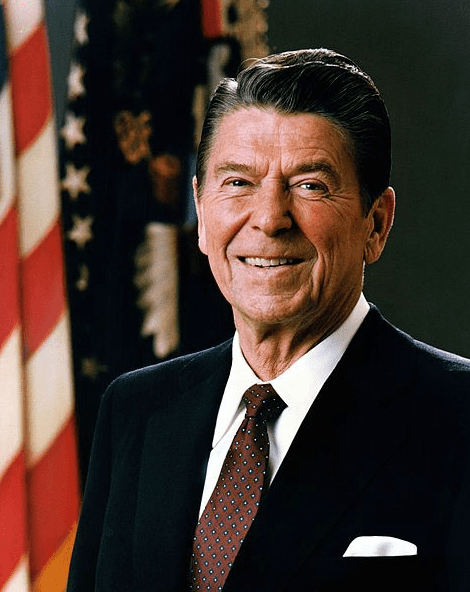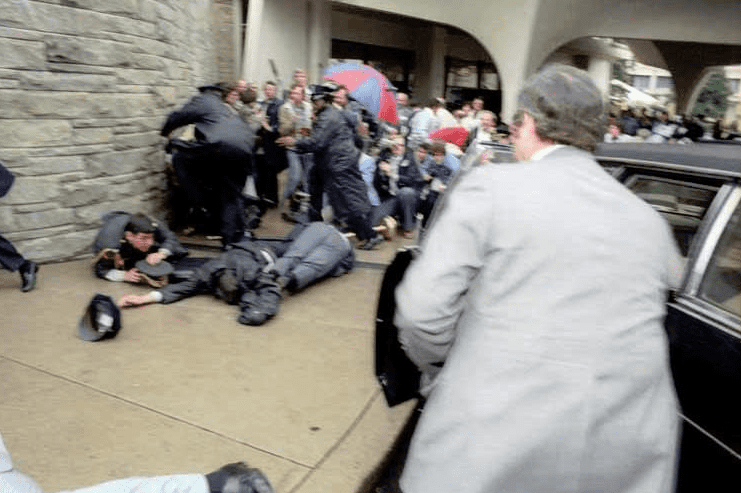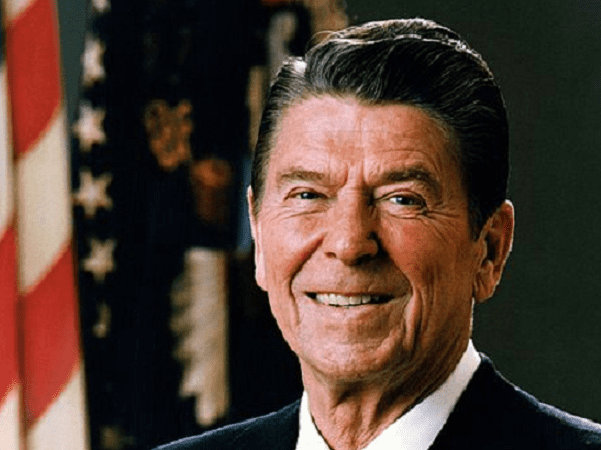During his presidency, Ronald Reagan was called the “Teflon President” because he could shrug off criticism and avoid blame for the scandals that affected members of his staff. On 30 March 1981, Reagan showed he could shrug off something far more severe than blame: a would-be assassin, John Hinckley, Jr., fired six shots point-blank at the president as he was leaving the Washington Hilton Hotel after giving a speech. Somehow, despite the short distance, all six shots missed hitting the president directly.

However, one bullet ricocheted off the limousine and penetrated Reagan’s left lung. Although Hinckley was using a deadly type of ammunition designed to explode upon impact, the bullet that entered Reagan did not explode, which surely would have killed him. It also stopped short of smashing into his heart, which also would have killed him. Instead of dying, the 70-year-old president survived the attempted assassination – and he did so with style.

When the presidential limousine pulled up to the emergency room of George Washington University Hospital, no stretchers were available – so Reagan walked right in, unassisted. When his wife Nancy rushed into the emergency room to join him, the president cracked: “Honey, I forgot to duck.” Once wheeled into the surgery room, Reagan looked up at the doctors and joked: “Please tell me you’re Republicans.” After surgery, with tubes in his mouth preventing him from speaking, Reagan scribbled a note: “All in all, I’d rather be in Philadelphia.”
It truly seemed this president could not be seriously touched – not by criticism, not by scandal, not by bullets. Somehow, Ronald Reagan always rose above it all. Unfortunately, the same could not be said of three other individuals wounded in the attempted assassination. White House Press Secretary James Brady was hit by the first shot; the bullet entered his brain, causing permanent brain damage. The second shot hit District of Columbia police officer Thomas Delahanty, who was shot in the back of his neck as he turned to protect the president. The fourth shot hit Secret Service agent Timothy McCarthy in the torso; he was doing his job, spreading his body over Reagan to protect the president, when he was hit.
The attempted assassination of President Ronald Reagan was front-page news for the nation’s newspapers, such as this one.
The two articles on this front page provide many details of the shooting.
Here is a transcription of this article:
Gunman Wounds Reagan in Assassination Attempt
Press Aide Brady, 2 Lawmen Also Shot
WASHINGTON (AP) – President Reagan was wounded in the chest Monday by a gunman who tried to assassinate him with a burst of .22-caliber bullets from a “Saturday night special.” White House press secretary James S. Brady was critically injured in the blaze of gunfire.
Reagan “sailed through surgery” according to doctors who said he’d be ready to make presidential decisions by today.
But Brady was said to be fighting for his life, a bullet through his brain.
Dr. Dennis O’Leary said “a really mangled bullet” was removed from Reagan’s left lung. He said the president’s condition was stable, the prognosis excellent, and that the president would probably be hospitalized for about two weeks.
“Honey, I forgot to duck,” Reagan told his wife as he was wheeled into surgery. Then he told the doctors he hoped they were Republicans.
A Secret Service agent and a policeman also were wounded in the mid-afternoon incident outside a Washington hotel where Reagan had just addressed a union convention. They were reported in serious condition but apparently not in danger.
A youthful, sandy-haired gunman from suburban Denver was wrestled into handcuffs and arrested moments after the gunman leveled his pistol at the president and fired six times from near point-blank range. The Secret Service identified him as John Warnock Hinckley, 25, of Evergreen, Colo.
There was no known motive, no explanation for the savage burst of gunfire that exploded as the president stood beside his limousine, ready to step inside for the one-mile ride back to the White House.
Roger Young of the FBI described the weapon as a “Saturday night special” and said it was purchased at a Dallas gun shop.
Hinckley was booked on charges of attempted assassination of a president, and of assault with intent to kill a police officer. He was in custody Monday night.
Young, the FBI spokesman, said there had been “no problem” with Hinckley’s coherence when questioned by authorities.
Hinckley was arrested last Oct. 9 at the Nashville airport for carrying handguns. The FBI said he was carrying three weapons that day – while then-President Carter was making a campaign appearance in the city.
Monday’s shooting occurred suddenly on an overcast Washington afternoon.
One of Monday’s eyewitnesses said the assailant, standing 10 feet from the president, “just opened up and continued squeezing the trigger.”
At 2:25 p.m. EST, six shots rang out, one hitting Reagan in the left chest, others felling Brady, a Secret Service agent and a policeman. Secret Service agents and police seized Hinckley – tossing him to the ground outside the Washington Hilton and pinning him to a wall.
Anxious hours later, Reagan was pronounced in good and stable condition.
Two and a half hours after emerging from surgery, Reagan joked with doctors in the recovery room, according to a White House statement.
“Despite the tubes in his mouth, he (Reagan) gave them a note that said, ‘All in all, I’d rather be in Philadelphia.’”
At the White House, Vice President George Bush said, “I can reassure this nation and a watching world that the American government is functioning fully and effectively. We’ve had full and complete communication throughout the day.”
O’Leary described Reagan as “clear of head” and said he “should be able to make decisions by tomorrow, certainly.
“We do not believe there is any permanent injury,” he added.
O’Leary served as spokesman for two surgeons who operated on Reagan at George Washington University Hospital. They made a 6-inch incision to remove the bullet that had penetrated about three inches into his left lung, missing his heart by several inches.
Reagan’s lung collapsed, and the surgeons inserted two chest tubes to restore it.
They gave him blood transfusions, about 2½ quarts in all, to replace the blood he lost.
The wounded president walked into the hospital, “alert and awake” if a bit lightheaded, O’Leary said. At 70, the doctor said, Reagan “is physiologically very young.”
“He was never in any serious danger,” O’Leary said.
But Brady was.
“His condition is critical,” the doctor said. He was shot in the side of the forehead, the bullet passing through his brain. “He obviously has significant brain injury and he is in critical condition,” O’Leary reported.
He would not speculate on Brady’s chances of recovery, but said that it is likely Brady, 40, will suffer permanent brain damage if he survives.
Lyn Nofziger, the Reagan aide who has assumed the role of principal press spokesman, told reporters later Monday night that the “prognosis is certainly better than it was earlier this afternoon.”
Brady came out of surgery at 8:15 p.m. EST, and Dr. Arthur Kobrine told Nofziger his vital signs were stable. Nofziger quoted the doctor also as saying that Brady’s pupillary reflexes were normal, an encouraging sign.
O’Leary and Nofziger both said President Reagan would be able to handle the decision-making duties of his job Tuesday.
Nofziger said there was no consideration of turning the duties of the office over to Bush under the constitutional provision for presidential disability.
“The president will be fully capable of making decisions tomorrow according to the doctors,” Nofziger said. “In the meantime the business of government is going on normally and we expect it will continue to.”
White House spokesman Larry Speakes said plans for Tuesday were “basically to continue the schedule the president has planned” with Vice President Bush filling in for Reagan.
The schedule included a Cabinet meeting, a session with congressional leaders and a working lunch with the prime minister of the Netherlands.
Asked if the president has turned over authority to the vice president, Speakes replied: “There has been no cause for that to happen.”
Dr. Benjamin Aaron and Dr. Joseph Giordano, both of the George Washington University School of Medicine, operated on Reagan.
O’Leary said Reagan might be hospitalized for as long as two weeks, but called that only a guess.
While Reagan was in the operating room, his aides made a point of emphasizing the banter with which he went to surgery, as reassuring evidence that he hadn’t been grievously wounded.
He winked, according to Nofziger, then saw three top staff members and said, “Who’s minding the store?”
“And when he got into the operating room, he looked at the doctors and he said ‘Please tell me you’re Republicans.’” According to O’Leary, the surgeons told him “today everyone is a Republican.”
While the operation progressed, the doctors gave Mrs. Reagan a preliminary report that matched their final prognosis: stable and good.
At about the same hour, Senate Majority Leader Howard H. Baker Jr. said he was told that Reagan’s “recovery is considered to be certain.”
Baker told the Senate his information came from Sen. Paul Laxalt, R-Nev., a close friend of the president, who was at the hospital with Mrs. Reagan.
All afternoon, the message was the same: reassurance that the president would recover, repeated statements that the government was functioning despite the attempted assassination.
The gunman leveled his pistol at Reagan from amid a crowd of newsmen and bystanders as the president left the hotel after addressing the AFL-CIO Building Trades Council.
The shots also felled Secret Service agent Timothy J. McCarthy, 31, and policeman Thomas Delahanty, 45. A Secret Service spokesman said McCarthy was in “stable condition on the plus side.” He was shot in the chest. Delahanty was wounded at the base of his neck. He was reported in serious condition.
At the time, Bush was flying to Austin, Tex. His plane turned back, landing outside Washington at dusk. Bush was flown to the city aboard a helicopter under extraordinary security precautions.
Key Cabinet members and Reagan aides conferred at the White House. With Bush in flight and Reagan in the hospital, Secretary of State Alexander M. Haig Jr. told reporters “As of now I am in control here in the White House pending the return of the vice president.”
Here is a transcription of this article:
Suspect Said Troubled Man; Neo-Nazi Link
The Associated Press
John Warnock Hinckley Jr., arrested Monday in an attempt on the life of President Reagan, recently had been under psychiatric care and had been arrested while carrying handguns in Nashville, Tenn., on a day former President Carter visited the city.
A former classmate said Hinckley was “not a flamboyant type” when they attended a suburban Dallas high school together and “certainly not the type” to shoot a president.
But little was known about Hinckley’s activities in the years after high school – except sporadic attendance at Texas Tech University – and hints emerged Monday of a troubled man and his weapons.
The head of a neo-Nazi group, the National Socialist Party of America, said Hinckley was a party member who quit in 1979 because “he felt that we were not sufficiently militant for him.
“We agreed mutually NSPA was not his cup of tea. He wanted us to go out and commit unlawful acts. We sort of carried on a debate about it,” said Harold Covington of Raleigh, N.C.
The federal government Monday night formally charged Hinckley with attempting to assassinate President Reagan and assaulting a Secret Service officer. He was held without bail by U.S. Magistrate Arthur L. Burnett pending a preliminary hearing set for Thursday at 10 a.m. EST.
Roger Young, an FBI spokesman in Washington, said the weapon used to shoot the president and three others was a .22-caliber “Saturday night special” purchased at a Dallas gun shop.
Young said there had been “no problem” with the suspect’s coherence when questioned by authorities. Young refused to elaborate on a possible motive for the shooting.
The operator of a Denver pawn shop said a man identifying himself as John W. Hinckley Jr. of suburban Lakewood pawned a guitar and a typewriter on March 11 and said he was “going out of town.”
The young man was shabbily dressed and “looked like a man down on his luck,” said Brent Morris, the clerk at G.I. Joe’s Pawn Shop.
In Evergreen, Colo., attorney Jim Robinson said in a statement from the suspect’s parents that young Hinckley has been under recent psychiatric care.
“His evaluation did not alert anyone to the seriousness of his condition,” the statement said. Robinson added that Hinckley’s parents were “heartbroken,” but would stand by their son.
Hinckley, 25, is a son of Denver businessman J. W. “Jack” Hinckley, president of Vanderbilt Energy Corp., an oil and gas exploration company. The family moved to Colorado in 1974. Hinckley was born in Ardmore, Okla., according to hospital officials there.
FBI agents interviewed Hinckley’s parents in Evergreen, a bedroom community where they live about 20 miles due west of Denver.
The Washington Post reported one of its reporters telephoned the Hinckley home an hour after the shooting and broke the news to Joanne Hinckley that her son was the suspect. She reacted with disbelief, saying, “This is a joke.” She said she had been watching television coverage of the shooting, and repeated, “This is a joke, isn’t it?”
But when asked if her son was in Washington, she replied, “I don’t know, I don’t know.” Her voice cracked and she hung up.
“He just sort of blended into the crowd,” said Tom Blackwell, who graduated, along with Hinckley, from Highland Park High School in suburban Dallas in 1973.
“He wasn’t a flamboyant type or anything like that.”
The FBI and police in Evergreen initially said Hinckley had no known criminal record. However, the FBI later confirmed he was arrested Oct. 9 in Nashville, Tenn., while carrying three handguns.
FBI agent Richard Knudsen, in Nashville, confirmed Hinckley’s arrest by airport police, but declined to provide further details. President Carter was visiting Nashville on the day Hinckley was arrested. Then-candidate Reagan was scheduled to stop in Memphis on that day, but canceled his visit.
Four days after that incident, Hinckley bought a pair of .22-caliber revolvers at Rocky’s pawn shop in downtown Dallas. Agents of the FBI and the Federal Bureau of Alcohol, Tobacco and Firearms seized records of the sale Monday, a few hours after Reagan was shot.
Isaac Goldstein, owner of the shop, said Hinckley used a Lubbock address in buying the weapons. The FBI declined to say whether one of them had been used in Monday’s shooting.
Blackwell said the last time he saw Hinckley was at graduation time, when Hinckley and his family were moving to Colorado. Little was known about his activities in the years since high school.
Hinckley entered Texas Tech University at Lubbock in the fall of 1973 as a business administration student. School officials said he last attended the school in the spring and first summer semester of 1980. Steve Lindell, assistant manager of university news and publications, said Hinckley had not earned a degree.
NBC News reported that Hinckley once worked as a disc jockey at a country music station in Denver under the name John Warlek.
The Texas Department of Public Safety listed Hinckley’s birthday as May 29, 1955, although initial Secret Service reports listed it as May 29, 1958.
His driver’s license described him as 5 feet, 9 inches tall, weighing 180 pounds, with blue eyes and blond hair.
Dr. E. A. Sigler, principal at Highland Park High, recalled having seen Hinckley as a student, but remembered “nothing special about him.”
“I was shocked to find out that he was one of my former students,” Sigler said.
Reporters and photographers swarmed through the school, but little information was available. Sigler said he could not release Hinckley’s confidential records.
The 1973 high school yearbook listed Hinckley as a member of the Spanish Club, the Student Government Club and the Rodeo Club.
Bill Lierman, a former teacher at Highland Park and sponsor of the Rodeo Club when Hinckley was there, said, “He was very quiet, very reserved. He didn’t give anyone any trouble… (he was) not a rowdy. He was a typical kid… fairly popular, best I can remember.”
Jim Francis, operations manager of the Brighton Co., a Dallas oil firm, and a fundraiser for Gov. Bill Clements, was Hinckley’s basketball coach from the 4th through 6th grades.
“As a kid, he was a beautiful-looking blond-headed little boy, a wonderful athlete,” he said. “I don’t know what may have happened since then to him, but he was really a leader. He was one of the best athletes on the team, and the best basketball player.”
Note: An online collection of newspapers, such as GenealogyBank’s Historical Newspaper Archives, is not only a great way to learn about the lives of your ancestors – the old newspaper articles also help you understand American history and the times your ancestors lived in, and the news they talked about and read in their local papers, as well as more recent events.
Related Articles:
